Abstract
One hundred and twenty six preterm infants, with a gestational age of 34 weeks or less, were studied to compare the predictive value of somatosensory evoked potentials (SEPs) with that of cranial ultrasound. A normal N1 latency was no guarantee of a normal outcome, nor did a persistently delayed N1 latency always correlate with a poor outcome. As a predictor of cerebral palsy, SEPs had a sensitivity of 44% and a specificity of 92%. The presence of a large haemorrhage (grade IIb/III) or cystic leukomalacia on cranial ultrasound predicted cerebral palsy with a sensitivity of 73.6% and a specificity of 83.1%. These results demonstrate that the role of SEPs recorded after median nerve stimulation is limited in preterm infants.
Full text
PDF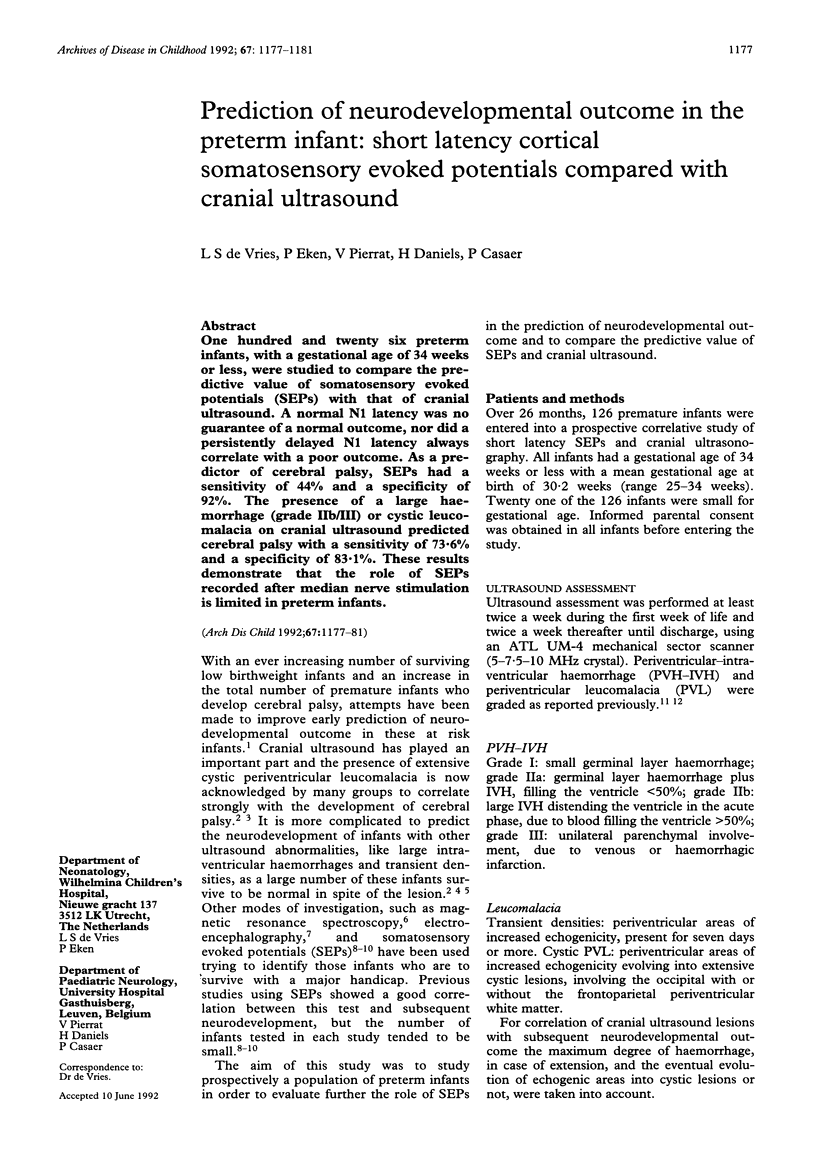
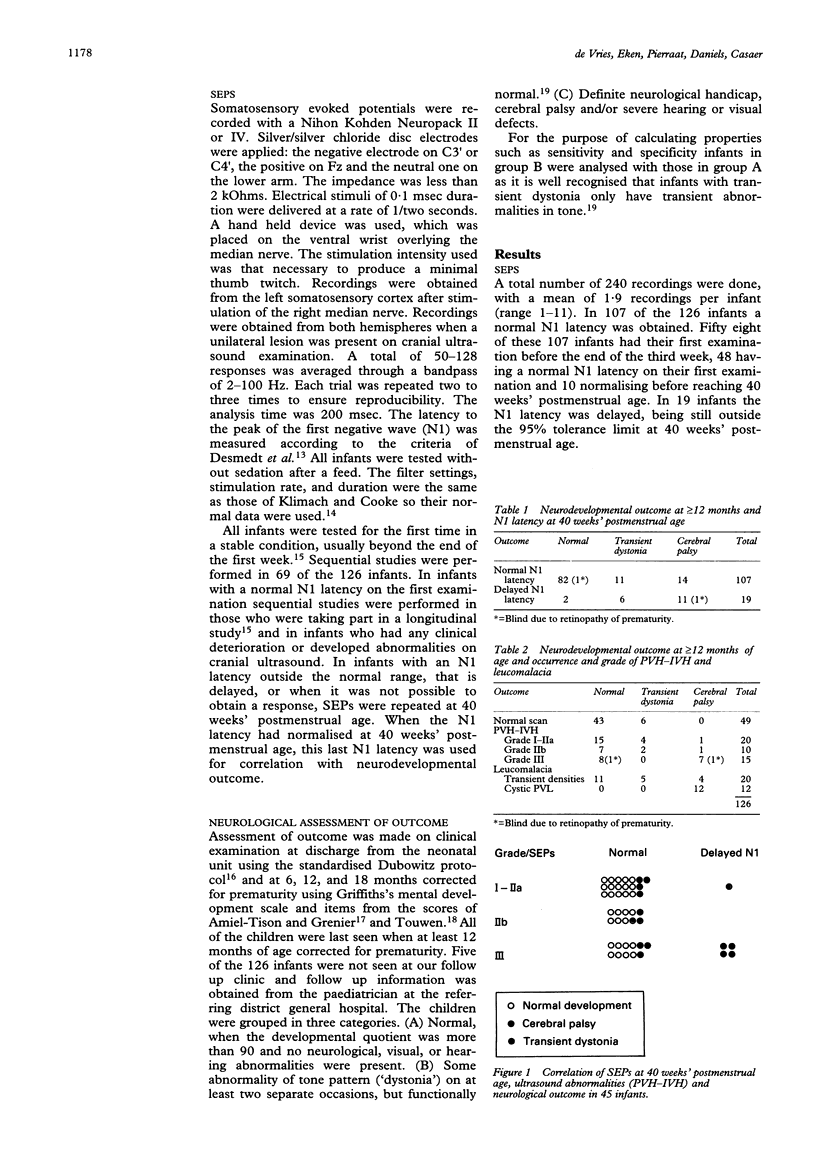
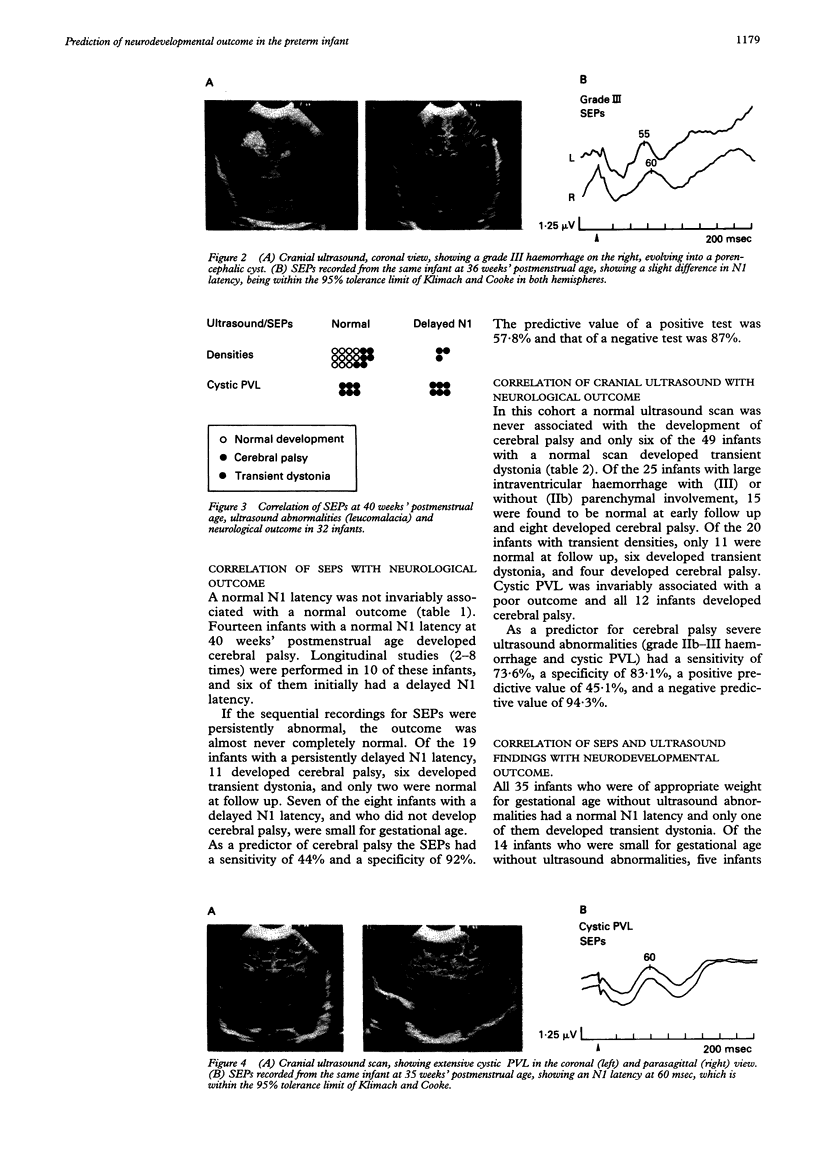
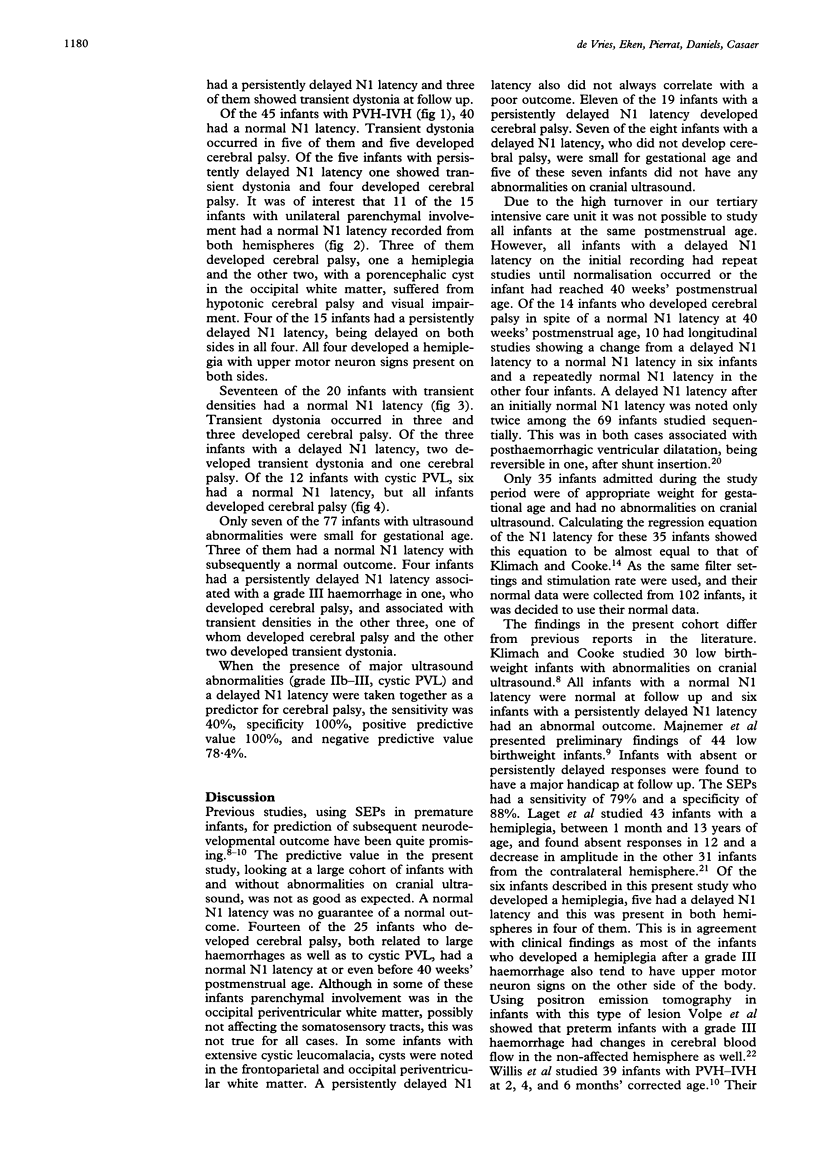
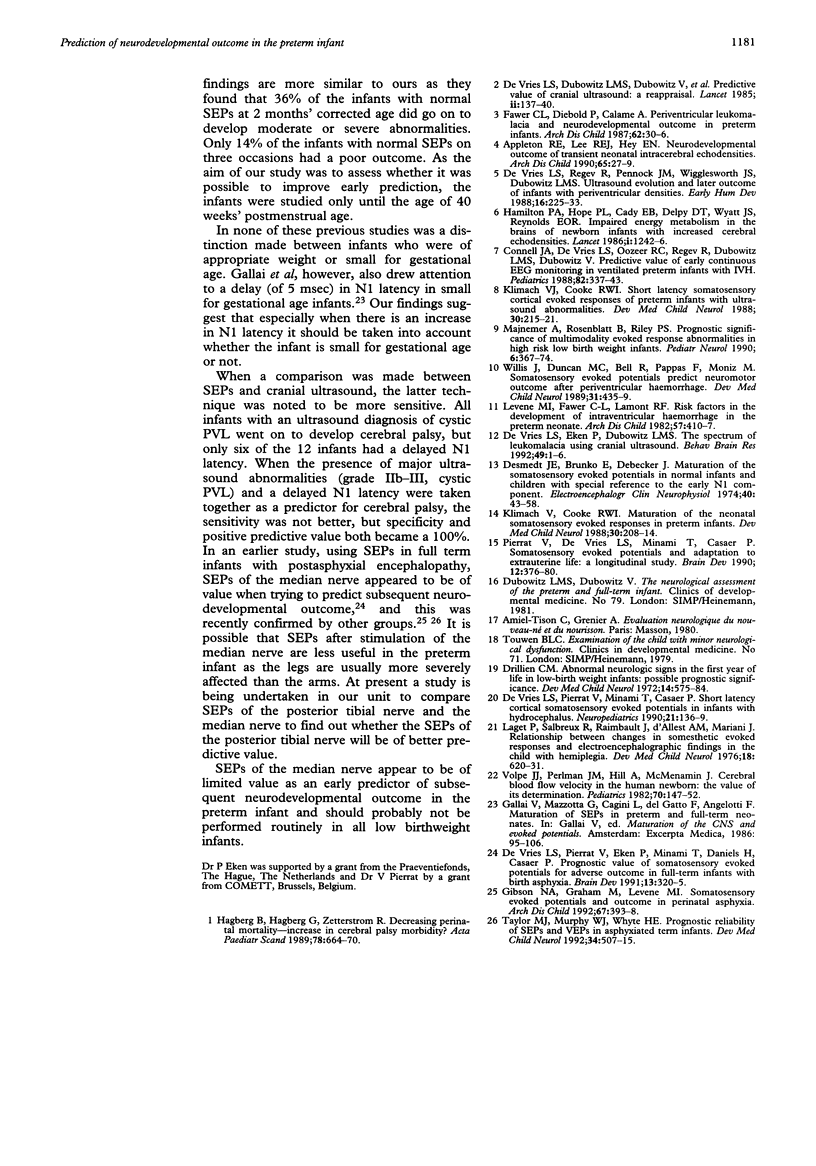
Images in this article
Selected References
These references are in PubMed. This may not be the complete list of references from this article.
- Appleton R. E., Lee R. E., Hey E. N. Neurodevelopmental outcome of transient neonatal intracerebral echodensities. Arch Dis Child. 1990 Jan;65(1 Spec No):27–29. doi: 10.1136/adc.65.1_spec_no.27. [DOI] [PMC free article] [PubMed] [Google Scholar]
- Connell J., de Vries L., Oozeer R., Regev R., Dubowitz L. M., Dubowitz V. Predictive value of early continuous electroencephalogram monitoring in ventilated preterm infants with intraventricular hemorrhage. Pediatrics. 1988 Sep;82(3):337–343. [PubMed] [Google Scholar]
- De Vries L. S., Pierrat V., Minami T., Smet M., Casaer P. The role of short latency somatosensory evoked responses in infants with rapidly progressive ventricular dilatation. Neuropediatrics. 1990 Aug;21(3):136–139. doi: 10.1055/s-2008-1071480. [DOI] [PubMed] [Google Scholar]
- De Vries L. S., Regev R., Pennock J. M., Wigglesworth J. S., Dubowitz L. M. Ultrasound evolution and later outcome of infants with periventricular densities. Early Hum Dev. 1988 Mar;16(2-3):225–233. doi: 10.1016/0378-3782(88)90103-x. [DOI] [PubMed] [Google Scholar]
- Desmedt J. E., Brunko E., Debecker J. Maturation of the somatosensory evoked potentials in normal infants and children, with special reference to the early N1 component. Electroencephalogr Clin Neurophysiol. 1976 Jan;40(1):43–58. doi: 10.1016/0013-4694(76)90178-4. [DOI] [PubMed] [Google Scholar]
- Drillien C. M. Abnormal neurologic signs in the first year of life in low-birthweight infants: possible prognostic significance. Dev Med Child Neurol. 1972 Oct;14(5):575–584. doi: 10.1111/j.1469-8749.1972.tb02639.x. [DOI] [PubMed] [Google Scholar]
- Fawer C. L., Diebold P., Calame A. Periventricular leucomalacia and neurodevelopmental outcome in preterm infants. Arch Dis Child. 1987 Jan;62(1):30–36. doi: 10.1136/adc.62.1.30. [DOI] [PMC free article] [PubMed] [Google Scholar]
- Gibson N. A., Graham M., Levene M. I. Somatosensory evoked potentials and outcome in perinatal asphyxia. Arch Dis Child. 1992 Apr;67(4 Spec No):393–398. doi: 10.1136/adc.67.4_spec_no.393. [DOI] [PMC free article] [PubMed] [Google Scholar]
- Hagberg B., Hagberg G., Zetterstrom R. Decreasing perinatal mortality--increase in cerebral palsy morbidity. Acta Paediatr Scand. 1989 Sep;78(5):664–670. doi: 10.1111/j.1651-2227.1989.tb11123.x. [DOI] [PubMed] [Google Scholar]
- Hamilton P. A., Hope P. L., Cady E. B., Delpy D. T., Wyatt J. S., Reynolds E. O. Impaired energy metabolism in brains of newborn infants with increased cerebral echodensities. Lancet. 1986 May 31;1(8492):1242–1246. doi: 10.1016/s0140-6736(86)91388-7. [DOI] [PubMed] [Google Scholar]
- Klimach V. J., Cooke R. W. Maturation of the neonatal somatosensory evoked response in preterm infants. Dev Med Child Neurol. 1988 Apr;30(2):208–214. doi: 10.1111/j.1469-8749.1988.tb04752.x. [DOI] [PubMed] [Google Scholar]
- Klimach V. J., Cooke R. W. Short-latency cortical somatosensory evoked responses of preterm infants with ultrasound abnormality of the brain. Dev Med Child Neurol. 1988 Apr;30(2):215–221. doi: 10.1111/j.1469-8749.1988.tb04753.x. [DOI] [PubMed] [Google Scholar]
- Laget P., Salbreux R., Raimbault J., d'Allest A. M., Mariani J. Relationship between changes in somesthetic evoked responses and electroencephalographic findings in the child with hemiplegia. Dev Med Child Neurol. 1976 Oct;18(5):620–631. doi: 10.1111/j.1469-8749.1976.tb04207.x. [DOI] [PubMed] [Google Scholar]
- Levene M. I., Fawer C. L., Lamont R. F. Risk factors in the development of intraventricular haemorrhage in the preterm neonate. Arch Dis Child. 1982 Jun;57(6):410–417. doi: 10.1136/adc.57.6.410. [DOI] [PMC free article] [PubMed] [Google Scholar]
- Majnemer A., Rosenblatt B., Riley P. S. Prognostic significance of multimodality evoked response testing in high-risk newborns. Pediatr Neurol. 1990 Nov-Dec;6(6):367–374. doi: 10.1016/0887-8994(90)90002-i. [DOI] [PubMed] [Google Scholar]
- Pierrat V., de Vries L. S., Minami T., Casaer P. Somatosensory evoked potentials and adaptation to extrauterine life: a longitudinal study. Brain Dev. 1990;12(4):376–379. doi: 10.1016/s0387-7604(12)80068-4. [DOI] [PubMed] [Google Scholar]
- Taylor M. J., Murphy W. J., Whyte H. E. Prognostic reliability of somatosensory and visual evoked potentials of asphyxiated term infants. Dev Med Child Neurol. 1992 Jun;34(6):507–515. doi: 10.1111/j.1469-8749.1992.tb11471.x. [DOI] [PubMed] [Google Scholar]
- Volpe J. J., Perlman J. M., Hill A., McMenamin J. B. Cerebral blood flow velocity in the human newborn: the value of its determination. Pediatrics. 1982 Jul;70(1):147–152. [PubMed] [Google Scholar]
- Willis J., Duncan M. C., Bell R., Pappas F., Moniz M. Somatosensory evoked potentials predict neuromotor outcome after periventricular hemorrhage. Dev Med Child Neurol. 1989 Aug;31(4):435–439. doi: 10.1111/j.1469-8749.1989.tb04021.x. [DOI] [PubMed] [Google Scholar]
- de Vries L. S., Dubowitz L. M., Dubowitz V., Kaiser A., Lary S., Silverman M., Whitelaw A., Wigglesworth J. S. Predictive value of cranial ultrasound in the newborn baby: a reappraisal. Lancet. 1985 Jul 20;2(8447):137–140. doi: 10.1016/s0140-6736(85)90237-5. [DOI] [PubMed] [Google Scholar]
- de Vries L. S., Eken P., Dubowitz L. M. The spectrum of leukomalacia using cranial ultrasound. Behav Brain Res. 1992 Jul 31;49(1):1–6. doi: 10.1016/s0166-4328(05)80189-5. [DOI] [PubMed] [Google Scholar]




